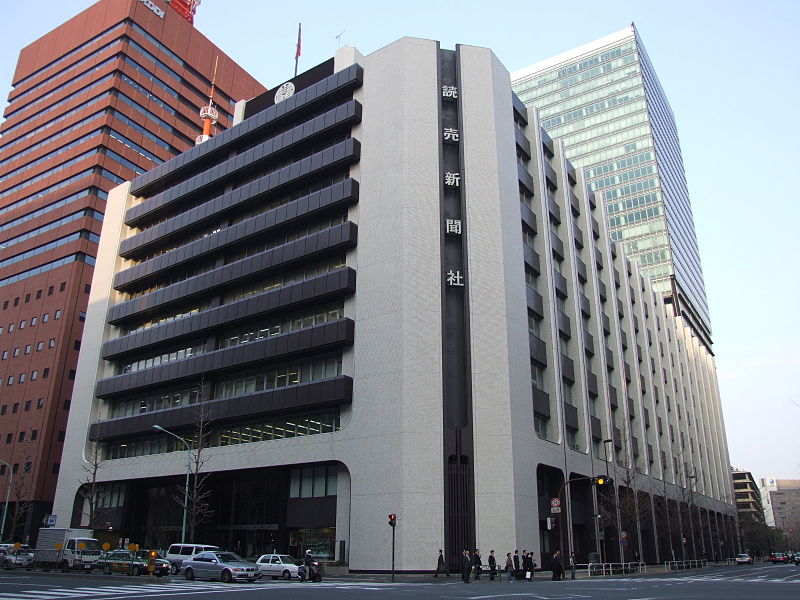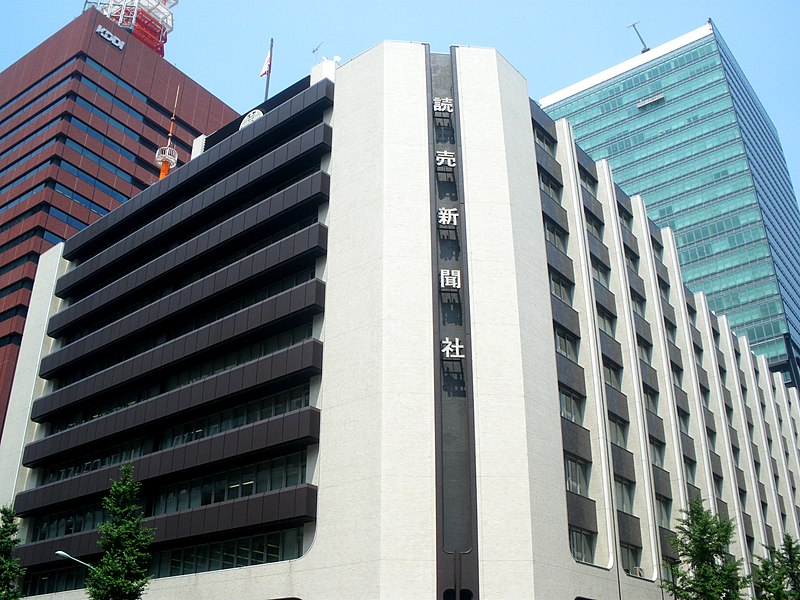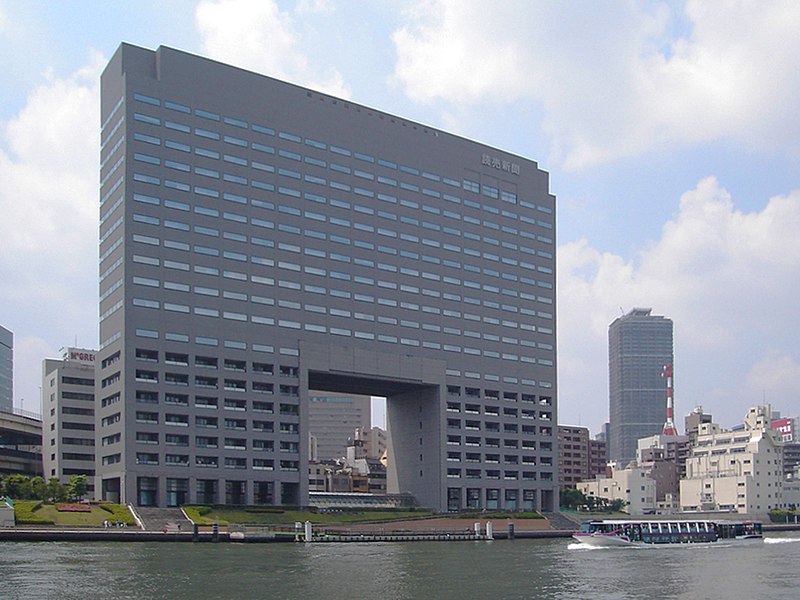The Yomiuri Shimbun (èªå£²æ–°èž, Yomiuri Shinbun) is a Japanese newspaper published in Tokyo, Osaka, Fukuoka, and other major Japanese cities. It is part of the Yomiuri Group, Japan's largest media conglomerate. It is one of the five national newspapers in Japan; the other four are the Asahi Shimbun, the Mainichi Shimbun, Nihon Keizai Shimbun, and the Sankei Shimbun. The headquarters is in Otemachi, Chiyoda, Tokyo.
Founded in 1874, the Yomiuri Shimbun is credited with having the largest newspaper circulation in the world, having a combined morning and evening circulation of 14,323,781 through January 2002. In 2010, the daily was the number one in the list of the world's biggest selling newspapers with a circulation of 10,021,000. As of mid-year 2011, it still had a combined morning-evening circulation of almost 13.5 million for its national edition. The paper is printed twice a day and in several different local editions.
Yomiuri Shimbun established the Yomiuri Prize in 1948. Its winners have included Yukio Mishima and Haruki Murakami.
History

The Yomiuri was launched in 1874 by the Nisshusha newspaper company as a small daily newspaper. Throughout the 1880s and 1890s the paper came to be known as a literary arts publication with its regular inclusion of work by writers such as Ozaki KÅyÅ.
In 1924, Shoriki Matsutaro took over management of the company. His innovations included improved news coverage, a full-page radio program guide, and the establishment of Japan's first professional baseball team (now known as the Yomiuri Giants).
The emphasis of the paper shifted to broad news coverage aimed at readers in the Tokyo area. By 1941 it had the largest circulation of any daily newspaper in the Tokyo area. In 1942, under wartime conditions, it merged with the Hochi Shimbun and became known as the Yomiuri-Hochi.
In February 2009, tie-up with The Wall Street Journal (WSJ) for edit, printing and distribution, then from March the major news headlines of the WSJ's Asian edition are summarized in the evening edition in Japanese.
The Yomiuri has a history of promoting nuclear power within Japan. During the 1950s Matsutaro Shoriki, the head of the Yomiuri, agreed to use his newspaper to promote nuclear power in Japan for the CIA. In May 2011, when the then Japanese prime minister Naoto Kan requested Chubu Electric Power Company to shut down several of its Hamaoka Nuclear Power Plants due to safety concerns, the Yomiuri responded with criticism, calling the move "abrupt" and a difficult situation for Chubu Electric's shareholders. It wrote Kan "should seriously reflect on the way he made his request." It then followed up with an article wondering about how dangerous Hamaoka really was and called Kan's request "a political judgment that went beyond technological worthiness." The next day damage to the pipes inside the condenser was discovered at one of the plants following a leak of seawater into the reactor.
In November 2014 the newspaper become controversial
Political stance

The Yomiuri Shimbun is conservative and sometimes considered a centre-right newspaper.
The Yomiuri newspaper said in an editorial in 2011 "No written material supporting the claim that government and military authorities were involved in the forcible and systematic recruitment of comfort women has been discovered", and that it regarded the Asian Women's Fund, set up to compensate for wartime abuses, as a failure based on a misunderstanding of history. The New York Times reported on similar statements previously, writing that "The nation's (Japan's) largest newspaper, Yomiuri Shimbun, applauded the revisions" regarding removing the word "forcibly" from referring to laborers brought to Japan in the prewar period and revising the comfort women controversy. More recently the Yomiuri editorials have opposed the DPJ government and denounced denuclearization as "not a viable option".
Other publications and ventures

Yomiuri also publishes The Japan News (formerly called The Daily Yomiuri), one of Japan's largest English-language newspapers. It publishes the daily Hochi Shimbun, a sport-specific daily newspaper, as well as weekly and monthly magazines and books.
Yomiuri Shimbun Holdings owns the Chuokoron-Shinsha publishing company, which it acquired in 1999, and the Nippon Television network. It is a member of the Asia News Network. The paper is known as the de facto financial patron of the baseball team Yomiuri Giants. They also sponsor the Japan Fantasy Novel Award annually. It has been a sponsor of the FIFA Club World Cup every time it has been held in Japan since 2006.
Digital resources
.jpg/800px-Yomiuri_Shimbun_(Chubu_Branch_Office).jpg)
In November 1999, The Yomiuri Shimbun released a CD-ROM titled "The Yomiuri Shimbun in the Meiji Era," which provided searchable archives of news articles and images from the period that have been digitalized from microfilm. This was the first time a newspaper made it possible to search digitalized images of newspaper pictures and articles as they appeared in print.
Subsequent CD-ROMs, "The Taisho Era", "The pre-war Showa Era I", and "The pre-war Showa era II" were completed eight years after the project was first conceived. "Postwar Recovery", the first part of a postwar Showa Era series that includes newspaper stories and images until 1960, is on the way.
The system of indexing each newspaper article and image makes the archives easier to search, and the CD-ROMs have been well received by users as a result. This digital resource is available in most major academic libraries in the United States.
Locations
.jpg/725px-Yomiuri_Shimbun_newspaper_clipping_(27_May_1959_issue).jpg)
- Tokyo Head Office
- 1-7-1, Otemachi, Chiyoda, Tokyo, Japan
- Osaka Head Office
- 5-9, Nozakicho, Kita-ku, Osaka, Japan
- West Japan Head Office
- 1-16-5, Akasaka, ChÅ«Å-ku, Fukuoka, Japan
Yomiuri Group

The Yomiuri Group conglomerate comprises many entities, including:
- Yomiuri Giants
- Nippon Television Network Corporation
- Yomiuri Telecasting Corporation
- Chuokoron-Shinsha, Inc.
- Yomiuriland, an amusement park
- Yomiuri Advertising Agency (also known as "Yomiko", later sold to Hakuhodo)
See also
- Media of Japan
- The Japan Times
- International Herald Tribune/Asahi Shimbun
- Jake Adelstein, an American investigative journalist and crime-writer who, in 1993, became the first-ever non-Japanese staff writer at the Yomiuri Shimbun
References
External links

- Yomiuri Shimbun Online (Japanese)
- The Japan News (English)
- Guinness World Record: Highest Daily Newspaper Circulation
- Yomiuri Advertising Agency (Japanese)

Posting Komentar